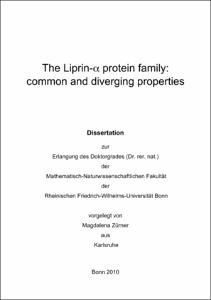Zürner, Magdalena: The Liprin-α protein family : common and diverging properties. - Bonn, 2010. - Dissertation, Rheinische Friedrich-Wilhelms-Universität Bonn.
Online-Ausgabe in bonndoc: https://nbn-resolving.org/urn:nbn:de:hbz:5N-23750
Online-Ausgabe in bonndoc: https://nbn-resolving.org/urn:nbn:de:hbz:5N-23750
@phdthesis{handle:20.500.11811/4699,
urn: https://nbn-resolving.org/urn:nbn:de:hbz:5N-23750,
author = {{Magdalena Zürner}},
title = {The Liprin-α protein family : common and diverging properties},
school = {Rheinische Friedrich-Wilhelms-Universität Bonn},
year = 2010,
month = dec,
note = {The Liprin-α family of scaffolding proteins is highly evolutionary conserved. While one homologue is present in invertebrates, it has diversified into four isoforms in mammals. In invertebrates, Liprin-α plays a crucial role in synapse assembly and maintenance as well as in synaptic vesicle trafficking. Little is known about the functional role of the four Liprin-α isoforms in the mammalian brain. The aim of this study was to examine the common and diverging properties of the four Liprin-α isoforms in order to gain insight into their role at the mammalian synapse.
A comparative characterization of the structure of the human and mouse Liprin-α genes and their regulation by alternative splicing showed that even though the genomic organization of the four isoforms is very similar, Liprins-α can be modified differentially in a developmental manner. To study the spatiotemporal expression pattern of the four Liprin-α isoforms we generated isoform-specific peptide antibodies. All four Liprin-α proteins are expressed in most neuronal populations of the brain, but each Liprin-α protein is characterized by a distinct expression profile. In particular, the spatiotemporal expression pattern of Liprin-α1 stands out. Expression of the most abundant isoforms, Liprin-2α and -3α, and the more weakly expressed Liprin-4α is restricted to the brain and increases during development. In contrast, Liprin-1α is expressed in all tissues tested, is present in glia, and has the highest expression level during development. The overlapping and distinct regional and subcellular localization of the Liprins-α indicates common as well as diverging functional roles. These results support the hypothesis that Liprin-1α might play a role in organizing protein complexes that are involved in cell migration.
Liprins-α are hypothesized to act as scaffolding proteins at the active zone. To gain a better understanding of the role of Liprin-α2 at the presynapse we analyzed its dynamics. We found that Liprin-α2 has a relatively slow turn-over which suggests that Liprin-α2 functions as a stably integrated scaffolding protein, thereby adding to the tenacity of the active zone.
For further investigations into the role of Liprins-α we identified shRNAs to knock down single isoforms as well as a point mutation to disrupt Liprin-α-RIMα interactions.
In summary, this study provides a thorough characterization of the Liprin-α family, and indicates a role in cell migration during brain development for Liprin-α1 and a role in synapse tenacity for Liprin-α2.},
url = {https://hdl.handle.net/20.500.11811/4699}
}
urn: https://nbn-resolving.org/urn:nbn:de:hbz:5N-23750,
author = {{Magdalena Zürner}},
title = {The Liprin-α protein family : common and diverging properties},
school = {Rheinische Friedrich-Wilhelms-Universität Bonn},
year = 2010,
month = dec,
note = {The Liprin-α family of scaffolding proteins is highly evolutionary conserved. While one homologue is present in invertebrates, it has diversified into four isoforms in mammals. In invertebrates, Liprin-α plays a crucial role in synapse assembly and maintenance as well as in synaptic vesicle trafficking. Little is known about the functional role of the four Liprin-α isoforms in the mammalian brain. The aim of this study was to examine the common and diverging properties of the four Liprin-α isoforms in order to gain insight into their role at the mammalian synapse.
A comparative characterization of the structure of the human and mouse Liprin-α genes and their regulation by alternative splicing showed that even though the genomic organization of the four isoforms is very similar, Liprins-α can be modified differentially in a developmental manner. To study the spatiotemporal expression pattern of the four Liprin-α isoforms we generated isoform-specific peptide antibodies. All four Liprin-α proteins are expressed in most neuronal populations of the brain, but each Liprin-α protein is characterized by a distinct expression profile. In particular, the spatiotemporal expression pattern of Liprin-α1 stands out. Expression of the most abundant isoforms, Liprin-2α and -3α, and the more weakly expressed Liprin-4α is restricted to the brain and increases during development. In contrast, Liprin-1α is expressed in all tissues tested, is present in glia, and has the highest expression level during development. The overlapping and distinct regional and subcellular localization of the Liprins-α indicates common as well as diverging functional roles. These results support the hypothesis that Liprin-1α might play a role in organizing protein complexes that are involved in cell migration.
Liprins-α are hypothesized to act as scaffolding proteins at the active zone. To gain a better understanding of the role of Liprin-α2 at the presynapse we analyzed its dynamics. We found that Liprin-α2 has a relatively slow turn-over which suggests that Liprin-α2 functions as a stably integrated scaffolding protein, thereby adding to the tenacity of the active zone.
For further investigations into the role of Liprins-α we identified shRNAs to knock down single isoforms as well as a point mutation to disrupt Liprin-α-RIMα interactions.
In summary, this study provides a thorough characterization of the Liprin-α family, and indicates a role in cell migration during brain development for Liprin-α1 and a role in synapse tenacity for Liprin-α2.},
url = {https://hdl.handle.net/20.500.11811/4699}
}






